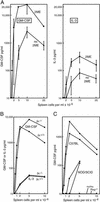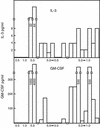Crowding-dependent production of colony-stimulating factors by cultured syngeneic or allogeneic hematopoietic cells
- PMID: 12552101
- PMCID: PMC298758
- DOI: 10.1073/pnas.252756999
Crowding-dependent production of colony-stimulating factors by cultured syngeneic or allogeneic hematopoietic cells
Abstract
Mitogenic stimulation in vitro of mouse T lymphocytes induces the production of the hematopoietic cytokines granulocyte-macrophage colony-stimulating factor and IL-3. The present experiments showed that simple crowding of murine spleen or lymph node cells was a sufficient inducing stimulus. Crowding did not have this consequence for thymus or marrow cells or spleen cells from nu/nu or Rag-1-/- mice lacking T lymphocytes. Crowding for as short a period as 24 h was sufficient to allow subsequent cytokine production in sparse cultures. Purified T lymphocytes also exhibited low levels of crowding induction of cytokine production and cytokine production was enhanced by IL-2 and IFN-gamma. However, IFN-gamma-/- spleen cells exhibited similar crowding-induced colony-stimulating factor production to that of control spleen cells. Excess cell crowding inhibited cytokine production. This inhibition was not caused by receptor internalization of cytokines but may contribute to the failure to observe IL-3 production in lymphoid organs in vivo. Coculture of allogeneic spleen or peritoneal cells was a strong inducing signal for colony-stimulating factor production but this parameter was unable to detect autoreactivity of T lymphocytes in mice that lack suppressor of cytokine signaling 1 and exhibit T lymphocyte activation.
Figures



Similar articles
-
AM5, a protein-associated polysaccharide, stimulates hematopoiesis and modulates the expression of endogenous hematopoietic growth factors in murine long-term bone marrow cultures.Stem Cells. 1995 Mar;13(2):175-85. doi: 10.1002/stem.5530130209. Stem Cells. 1995. PMID: 7540471
-
Selective production of interleukin 3 (IL3) and granulocyte-macrophage colony-stimulating factor (GM-CSF) in vitro by murine L3T4+ T cells: lack of spontaneous IL3 and GM-CSF production by Ly-2-/L3T4- lpr subset.Eur J Immunol. 1988 Sep;18(9):1367-72. doi: 10.1002/eji.1830180910. Eur J Immunol. 1988. PMID: 3139430
-
Production of colony-stimulating factors and IL-5 by organs from three types of mice with inflammatory disease due to loss of the suppressor of cytokine signaling-1.J Immunol. 2001 Oct 15;167(8):4661-7. doi: 10.4049/jimmunol.167.8.4661. J Immunol. 2001. PMID: 11591796
-
Interactions among colony-stimulating factors, IL-1 beta, IL-6, and kit-ligand in the regulation of primitive murine hematopoietic cells.Exp Hematol. 1992 Mar;20(3):339-49. Exp Hematol. 1992. PMID: 1373685
-
T cells in the spleen: localization, cytokine production and cell/cell interactions.Res Immunol. 1991 May;142(4):334-9. doi: 10.1016/0923-2494(91)90086-x. Res Immunol. 1991. PMID: 1925001 Review. No abstract available.
References
-
- Parker J W, Metcalf D. J Immunol. 1974;112:502–510. - PubMed
-
- Cline M J, Golde D W. Nature. 1974;248:703–704. - PubMed
-
- Staber F G, Hültner L, Marcucci F, Krammer P H. Nature. 1982;298:79–82. - PubMed
-
- Kelso A, Metcalf D. Adv Immunol. 1990;48:69–105. - PubMed
-
- Schreier M H, Iscove N N. Nature. 1980;287:228–230. - PubMed
Publication types
MeSH terms
Substances
Grants and funding
LinkOut - more resources
Full Text Sources
Medical
Research Materials

